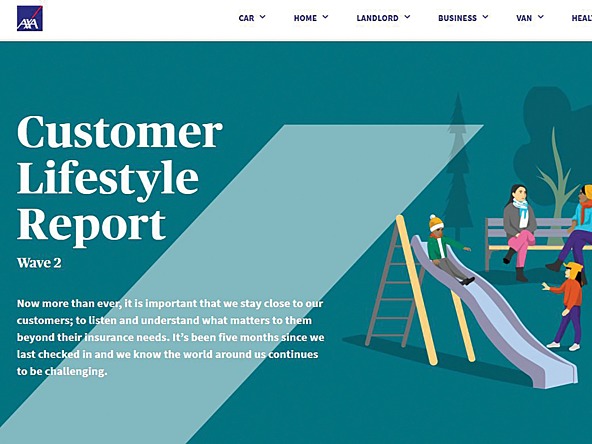Risk and reward: How Axa uses insight to focus on the sum of the parts

In an uncertain world, the escalating frequency of global risks is intensifying the focus on the insurance industry’s readiness to act as a ‘financial safety net’ for society. That’s according to a paper published by Deloitte, which also reported that this shift is resulting in a drive by firms to become more consumer-centric.
“This may be the formerly elusive game-changing moment that elevates the role and understanding of the insurer in the lives of their clients and communities,” the 2024 global insurance outlook report concluded.
The UK may, officially, be out of a recession, but uncertainty continues, with businesses and individuals still under pressure and facing greater levels of volatility. It was this changing environment for financial services firms that Patrick Alcantara entered when he joined Axa, one of the largest global insurers, as strategic customer insight lead for UK and Ireland in December 2022.
Alcantara, who previously led insight for insurance at the Co-op, was appointed to look after Axa’s insight for the UK and Ireland across a broad ‘transversal’ team, which works with the embedded insight units across various businesses – including Axa Health, Axa Retail, and a commercial team covering business insurance.
“We sit side by side with those business units in the UK and Ireland, and my role is about looking into what we call transversal tools and methods that make it easier for us to gather insight, but also make sense of it,” says Alcantara. “When we talk about transversal insight, we tend to talk about insight that cuts across the different business units.”
Having a central team specifically for overarching insight focuses on the ‘sum of the parts’– the expansive issues affecting Axa’s customers that resonate across the business, such as the cost of living and climate change. Alcantara’s team works to create research standards and efficiencies, and to inform strategy.
It also seeks to complement the work of the research units within the business, which collect insight that is more specific to their area: proposition-related insight that is more specific to their individual business area, such as car insurance, for example.
Doing your duty
On 31 July 2023, the Financial Conduct Authority’s consumer duty came into force. The new rules set a higher standard of protection for consumers and place more responsibility on financial services firms to communicate their products and services clearly.
With such a wide-ranging regulation, there was a need for a central approach to testing that could be applied across Axa’s various business units.
“In a nutshell, the consumer duty is about having a higher standard of care for our customers and linking what we do to specific customer outcomes,” says Alcantara. Those outcomes could relate to the way in which the company communicates with its customers, or designs products and services; the way in which it supports customers; or its pricing.
Crucial to building those outcomes is Axa’s ability to speak directly with customers to test its products, services and communications with them.
Part of Alcantara’s remit is to look at the best way of complying with the regulation and putting in place a consistent way of testing ideas with customers – or testing, in general – across the various parts of Axa.
“We wanted to be able to show the regulator that we have a consistent way of doing that, but, at the same time, show internal stakeholders that there is a more consistent way of doing things and that it’s more cost-effective. It reduces duplication. It also helps us log what we are doing in a central place and then use that as evidence for the regulator to show that we are complying with the regulation.”
With those outcomes in mind, the solution the team landed on was a customer panel, working with agency partner Redblue. As well as allowing Axa to test ideas and comms directly, and ask customers about their experience, the panel functions as a “transversal resource across different business units”, says Alcantara.
By offering a readily available pool of customers for research, the panel has made research more cost-effective and more operationally efficient, he says.
This is because, when testing comms, two different parts of the business could be asking the same questions, because they are talking to a similar group of customers. Alcantara adds: “You get to talk to your customers much quicker than if you did separate, disparate pieces of research on your own, but you also have that opportunity to put research all in one place, under the UK and Ireland umbrella.”
As part of this work, the team is logging all its research, including how much has been spent and what goals or outcomes have been met. It’s helping Axa to provide a body of evidence of its “consistent regime of customer testing” to stakeholders and the regulator, says Alcantara.

Cost-of-living crisis
Transversal insights are not only those affecting consumers or customers, but also those that cut across the market at large.
For example, Axa’s customer lifestyle report has a core question set about the cost of living. The report surveys customers about their financial outlook, spending habits, and challenges they are facing with their personal finances, including areas on which they are potentially cutting back.
The individual business units can also ask their own, more specific, questions within the survey. In the second wave, released just before Christmas last year, the Axa Health team asked questions about mental health and the impact of cost-of-living pressures.
The project highlights what a transversal insight team can do, according to Alcantara. “We see the sum of all parts, and we are able to also call on the different embedded insight teams to contribute to this big piece of research.
“It gives us an opportunity to get closer to our customers and be really, shamelessly, customer-focused, because we are talking about them. We’re not talking about insurance products here; it’s: ‘What are your challenges? What are you are concerned about?’.”
Data from the lifestyle report is used to inform decision-making within the different businesses, with one example being ongoing work on inclusive products, Alcantara says.
“One of our priorities at the moment is inclusive insurance. One of the things we’re trying to do is to show that we can provide more inclusive products as well. But the question is: what does that look like and how are you able to create those products?
“You need to really lean on a piece of research, such as the customer lifestyle report – lean into customer needs and the things that they are concerned about, to start answering that question.”
Accurate journeys
Like many other large businesses, regardless of sector, customer-journey mapping is an important element of Axa’s insight work. Alcantara’s team is responsible for validating the journeys – across the different businesses – to ensure that the maps accurately reflect what Axa customers actually experience.
Alcantara says: “The ability to come up with a recommended consistent approach to validation testing helps us compare apples with apples, so we are comparing journeys like for like – but, also, we are making it more efficient, so it’s easy to industrialise and it’s much more cost-effective.”
That consistency isn’t restricted to processes. Alcantara adds: “It also helps us to show up as ‘one Axa’ to our customers, because we have a consistent way of talking to them and a consistent way of doing research.”
Redblue is involved in the project to validate what Axa is finding in terms of customer journeys. Tom Scrimgour, managing director, says: “When you buy an insurance product, you are not thinking about anything aside from ‘how quickly and cost-effectively can I get this car insurance?’ We are taking all of [Axa’s] work and speaking to some consumers to round it out and validate what they are seeing, and try to bring a bit more of the consumer perspective into it.”
As well as “giving the answer” to the question in that specific part of the business, Scrimgour says the agency is working on designing processes that might be followed across other parts of the company. “It’s about saying, ‘if this is a really important journey, this is the process we might follow’. And, because this is important, we need to validate it with some research. You’re designing something that then goes further and wider.”
On the agency’s work with Axa, Scrimgour adds: “There is a need, at every junction, to be trying to drive the research agenda, as well as doing the research.”

Evaluating the approach
Consistency and cohesion are desired outcomes of this way of working, but another perspective is cost. Coursing research in the first instance to a customer panel has helped to realise cost efficiencies, as well as operational ones, says Alcantara.
“We have only had it [the panel] for a few months, but we’re more or less saving around a quarter – 23% on average – than if we just decided to do research ad hoc, or as different business units.”
Is this about simply doing less research? While the team has made cost savings, for Alcantara it’s important to have upfront conversations about the best approach to take.
“A lot of the conversations we have in the organisation are about resolving that healthy tension and really finding out when it’s best to [do research] transversely and when it’s best to do things more locally.
“There will be instances when you would need more bespoke, advanced work that is related to your business. It’s all about being open about the challenge that you’re trying to solve.”
Another, less quantifiable take on value is the impact of how the team influences decision-making within Axa. Alcantara cites the example of the company’s ‘voice of the customer’ programme, which gets feedback from 8.9 million customers across the UK and Ireland. One of the longer-term projects Alcantara is involved in is connecting the insight from that programme within an insights management framework, as well as ensuring consistency in tools and methods for customer feedback. Senior stakeholder buy-in is key.
“Getting the board to agree that, fundamentally, it is a good idea for us to connect insight helps with their decision-making, because they would be able to see things end to end and act on it much quicker. It also helps us to become more consistent and more cost-effective.”
Connecting the learning
Within Axa, insight colleagues across the UK and Ireland meet monthly to share their insights via an insight community hub called INCH, offering an opportunity to contribute to wider discussions.
Alcantara says: “We talk about what we’ve done, our successes, and our challenges. We also take the opportunity to signpost the research that we have been gathering.”
The forum has existed for the past year and is part of efforts to build an insight community across the different parts of what is a complex business.
In addition to the work his team is doing to connect insight within Axa, one of Alcantara’s priorities is to look to all agency partners for inspiration and to work more consistently with them to “maximise” the insight they are producing.
Looking to the future, he feels a combination of customer understanding and market nous will be key to staying as competitive as possible – and joined-up thinking will be central to that.
“Axa is a trusted household name and we’ve been in the market for a long time; that, in itself, really brings a lot of equity and respect from the customers that we serve, as well as the industry at large. However, as an organisation, we don’t want to sit on our laurels,” Alcantara says.
“If we are able to create best-in-class customer understanding, we would be in a position to offer distinctive, disruptive, inclusive products to our customers. That is also coupled with a keen sense of knowing market conditions, because we do operate in a highly regulated competitive market.
“How, then, do we anticipate or get better at acting on these changes in such a highly regulated competitive market? Part of the solution is leaning into the insight that we gather – and, I think, joining up that insight.”
This article was first published in the July 2024 issue of Impact; the final issue of the magazine. Impact content can be read here.

We hope you enjoyed this article.
Research Live is published by MRS.
The Market Research Society (MRS) exists to promote and protect the research sector, showcasing how research delivers impact for businesses and government.
Members of MRS enjoy many benefits including tailoured policy guidance, discounts on training and conferences, and access to member-only content.
For example, there's an archive of winning case studies from over a decade of MRS Awards.
Find out more about the benefits of joining MRS here.














0 Comments